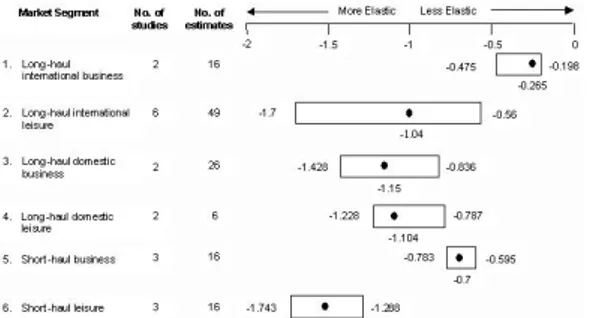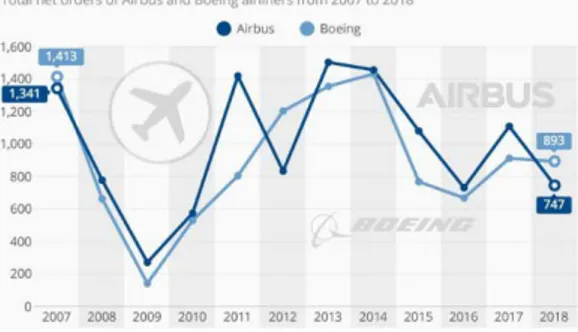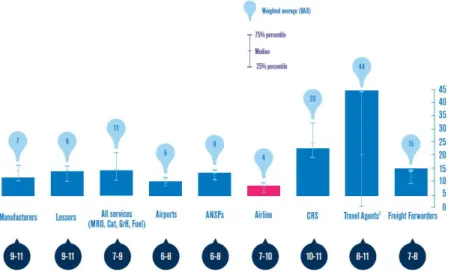A Work Project presented as part of the requirements for the Award of a
master’s degree in finance from the NOVA – School of Business and
Economics.
Lufthansa AG – Individual Report – Airline Industry five Porter’s forces Analysis
João Guilherme Silva (34004)
A Project carried out on the master’s in finance Program, under the
supervision of:
Rosário André
Abstract
The Airline industry is a very competitive industry that influences and gets
influenced by the overall economy. Globalization and market liberalization have
made flying more accessible then ever, which in turn has shaped in many ways,
how we live today. In this report I will analyze the profitability of the airline industry
from the perspective of the five forces model by Michael Porter in order to get a
deeper, more intuitive understanding of the industry. This report is also a support
document for the equity research on Lufthansa that me and my work project
colleague have been developing
Keywords (up to four):
· Airline Industry
· Porter’s five forces framework
· Airline supply chain
· Cost of air travel
This work used infrastructure and resources funded by
Fundação
para
a
Ciência
e
a
Tecnologia
(UID/ECO/00124/2013, UID/ECO/00124/2019 and Social
Sciences DataLab, Project 22209), POR Lisboa
(LISBOA-01-0145-FEDER-007722 and Social Sciences DataLab,
Project 22209) and POR Norte (Social Sciences DataLab,
Project 22209).
Why Porter’s five forces analysis:
During the making of our report we often took the side of supply, as it is more objective, or at least more easily predictable, as there are investments and production plans from both Lufthansa and suppliers. As such, during the task of prioritizing analysis for our valuation, it was decided we would drop this analysis in benefit of other, more urgent topics. Nonetheless, it seems fitting to me that I take the individual report opportunity to delve deeper in to the nuances of the industry as a whole and distance myself from Lufthansa per se, to understand better, both how to critically see Lufthansa’s strategy and to understand future developments in the sector.
Porter’s five forces Framework:
I decided to utilize the classic five forces model instead of the six forces model. The sixth force is the presence of complementary products and it seems this force is the least important and, additionally, has even lost importance in recent times due to the diminishing share of travel purchased trough agencies and has such the use of travel bundles as well.
A Porter’s five forces analysis of the Airline Industry
The airline business has a been a profitable, high-competition world and to illustrate this we conducted an analysis of Porter’s Five Forces Framework. The profitability is backed by ten years of profits in the industry and 2020 is projected to continue the positive net profits trend. This widely accepted model evaluates the profitability, or attractiveness, of a sector by analyzing 5 market forces, the higher the force, the less attractive the market. I will analyze the strength of each force.
Figure 2 - Net profit of commercial airlines worldwide from 2006 to 2020(in billion U.S. dollars)
Source: Statista 2020
Bargaining power of costumers:
The main visible consequence of the costumer’s power can be seen by the way recent cost decreases have been passed on to customers. The real price of air travel has decreased substantially over the last decades. One could argue that this could be driven mainly due to industry rivalry, but the fact is that demand as also substantially increased, and it would be more profitable for the industry if they kept more value for themselves, but the fact that they are not able to shows the power of the costumers.
One crucial discussion to understand the client’s power is if an airplane ticket should be viewed as a commodity or not. From my research there’s no unanimous answer for this question and it seems it depends on the type of costumer we are referring to. There are different types of costumers with different views on the subject and consequentially different levels of power. The main division is between business and leisure travelers. Business travelers respond well to frequent-flyer programs and tend to be more responsive to differentiated services and schedules than leisure ones, they are also less prone to risking a late or cancelled flight. These costumers have less negotiating power and don’t see tickets as commodities. On the other hand, leisure costumers rank much higher in price sensitivity and thus have a higher bargaining power. Cargo costumers have also high power due to concentration as they are mainly centralized in freight forwarders
Switching costs are also considerably lower for leisure costumers (as business ones are more responsive to frequent-flyer programs) and this gives even more negotiating power to the client side.
In conclusion, the costumers have a medium to high negotiating power, clear mainly trough the price statistics that prove decreasing costs for this stake holder group.
Figure 4 - Number of scheduled passengers (Millions) boarded by the global airline industry from 2004 to 2020
Source: Statista 2020
Figure 3 - Decreasing real cost of air travel
Source: IATA Economic Performance of the Airline Industry, End-Year 2019
Figure 5 - Different price-elasticities by costumer type Source: Canada Department of Finance
Bargaining power of Suppliers:
The suppliers group has three main sub-groups, engine/aircraft manufacturers, labor providers and airports. As a group, suppliers have higher returns on capital than the airlines themselves.
The worldwide production of commercial aircraft of more than 100 was an oligopoly that got progressively smaller, until 1997, when it became a duopoly (AirBus and Boeing). However, competition remains really high due to the risks associated with sunk cost (specific investments that cannot be used for another activities). The construction of a new model requires an investment between 10 and 15 billion of dollars, with a very long production process.
Moreover, for airline company, the cost of an airplane engine is not only the purchasing cost, but also the maintenance and servicing costs. Airline companies are therefore looking for high sustainability and rentability products, with a very high level of requirement which increases the degree of competition.
The labor providers are highly unionized, with specific unions for each labor type, all with the capacity of disrupting operations on their own which increases their own negotiation power. This power associated with higher regulations has considerably decreased the flexibility of airlines in terms of staff levels and wages.
Airports are, most of the times, operating in monopoly, with no easy alternative. This comes with a very high pricing power to airports, depending on the amount of demand from clients or airlines for that specific airport. The switching costs for airlines are higher for network carriers that operate in a hub-related way and lower for LCC’s. They also have a very big influence on one of the key value drivers for the industry, capacity. Recently Australian airlines tried to fight airports monopoly in a campaign called unfAirports, but authorities found their pleas unfounded.
Figure 6 - Airbus and Boeing rivalry Source: Forbes + Statista
Figure 7 - Commom strike headlines Source: DW.com
Figure 8 - Airlines trying to fight airport monopoly Source: Travel daily news
In conclusion the suppliers have a high bargaining power, evident mainly by the fact that along the Value chain of the airline industry, most suppliers have higher returns on capital invested than the airlines themselves, as found by a study conducted by Mackenzie for IATA in 2015
Threat of new entries:
Most of what we consider new entries are incumbent airlines expanding operations to other areas which eliminates most of the barriers to entry because they already have necessary scale to guaranty load factors and high brand awareness. Distribution channels are also way easier to access for new players than traditionally, due to the shift of the platform in which distribution happens from travel agencies to internet centralized platforms. However, the industry still has relatively low barriers to entry when compared to the last decades, with more widespread leasing and less government regulations for routes and licenses. There are, however, high barriers to exit due to the sector, by the nature of it, having very high fixed costs. Making even companies that make little
Figure 9 - Costs of capital at the bottom, bars represent ROIC Source: McKinsey for IATA, 2015
Figure 10 - 2017 growth for online travel agencies Source: Mauricio Preto’s report on medium.com
to no profit stay in business to be able to pay back invesors/financers. Threat of new entries is medium.
Threat of substitutes:
In long distance travel there is not much possibility for substitute products as air travel is definitely faster and cheaper than most other possibilities, especially with the offer of destinations and the real cost of kilometer flown going considerably up and down, respectively, in the last decades. The biggest threat of substitution, in a way, is not a different way of travelling, but the decision not to travel. This affects both long and short-haul flights and it is made possible, for example, through new communication technologies like web meetings and similar solutions that make traveling less essential. This possibility is also increased by environmental preoccupations. As we can also see in the same graph (left) CO2 emissions, measured by kg/passenger are considerably higher in the airplane case. Overall though, threat of substitutes is low, as for many cases, there no other feasible replacement for flight.
Rivalry in the industry:
By far the force that most brings down profitability in the sector is the intra-industry competition. There are inherent characteristics of the business that make it prone to high intensity of competition.
A big reason for very strong down price pressure is the perfect storm between cost structure and the perishables nature of the product. Since for every ticket sold the majority of its cost is sunk cost (airplane is taking off either way) and they are perishable, (unused seat on flying airplane) that makes the marginal cost of a seat in the plane extremely low, which allows companies, when they want to fill a flight, to push prices down hurting every player and benefiting the consumer. In an industry like this, incumbent players with high cash positions will practice predatory prices (below operating costs) in order to push newer ones out of the market. As recently as 1/Jan/2020, the Indian aviation minister warned about predatory prices happening in India. Rivalry amongst players is high.
Figure 11 - Planes cheaper and faster than trains, especially on higher distances
Source: DW Data
Figure 12 - Indian aviation minister wars about predatory prices in the airline industry




